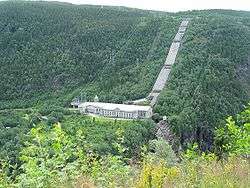Vemork
Vemork is the name of a hydroelectric power plant outside Rjukan in Tinn, Norway. The plant was built by Norsk Hydro and opened in 1911, its main purpose being to fix nitrogen for the production of fertilizer. At opening, it was the world's largest power plant with a capacity of 108 MW.[1]

Vemork was later the site of the first plant in the world to mass-produce heavy water developing from the hydrogen production then used for the Haber process. During World War II, Vemork was the target of Norwegian heavy water sabotage operations. The heavy water plant was closed in 1971, and in 1988 the power station became the Norwegian Industrial Workers Museum.
A new power plant was opened in 1971 and is located inside the mountain behind the old power plant.[2]

History
In 1906, the then newly founded Norsk hydro-elektrisk Kvælstofaktieselskab started construction of what was to be the world's largest hydroelectric power plant. The 108-MW Vemork power station at the Rjukan waterfall was the world’s largest power plant when it opened in 1911, after four years of construction.[1] The project was so expensive that the works had to be financed by overseas sources. The plant became the corporate precursor to Norsk Hydro. Ten 6-MW T/G sets were supplied by Voith and AEG (units 1-5) and Escher Wyss and Oerlikon (units 6-10).
In 1911, construction was complete. The plant, itself, was built to power a factory producing artificial fertilizer by a new method invented by Kristian Birkeland. Later, Norsk Hydro developed and realized another project—the production of heavy water by means of electrolysis. The company built a unit for producing high concentrations of heavy water at the Vemork plant at Rjukan, although for what purpose was not stated. Production started in December 1934.
Heavy water sabotage

In 1940, the French Government purchased the entire stock, then available, of heavy water from Norway. The Germans had also offered to purchase it, but the Norwegian Government was told of its possible military use and gave it to a French agent, who smuggled it to France via England. That supply eventually went back to England. (see Tube Alloys#The Paris Group)
During the German occupation of Norway in World War II, the production of heavy water was judged to be a serious enough threat that at least five separate attacks were launched [3] in order to prevent the Germans from making an atomic bomb.
- On 18 October 1942, four Norwegian SOE (Special Operations Executive) agents were parachuted in on a reconnaissance operation code-named 'Grouse'.
- On 19 November 1942, Operation Freshman was conducted by the British as a Combined Operation involving the RAF and the Army, using two Halifax bombers, each towing a glider. Three of these aircraft crashed, and the survivors were captured and executed by the Germans.
- In February 1943, SOE's Operation 'Gunnerside' parachuted another six Norwegian agents into the area, to join forces with the four from 'Grouse'. They successfully attacked the Rjukan electrolysis plant on the night of 28 February-1 March 1943, with the loss of 500kg of heavy water and destruction of the heavy-water section of the plant.
- On 16 November 1943, an American air raid took place, but there was minimal damage to the electrolysis building.
- On 20 February 1944, a successful attack by Norwegian resistance sank the ferry "D/F Hydro" that was taking a shipment of heavy water to Germany.
It was later discovered that the Germans were not as close to making an atomic bomb as had been initially feared.
Today, the original power plant is an industrial museum. Its exhibitions cover both the heavy-water sabotage operations and the early Norwegian labor movement.
Other media
A Norwegian movie about the sabotage operation against the heavy water power plant was made in 1948, starring several of the original saboteurs, and titled "Kampen om tungtvannet" (Norway), "La Bataille de l'eau lourde" (France) and "Operation Swallow: The Battle for Heavy Water" (USA).[4]
In 1965, director Anthony Mann made a rather less accurate film version of the story entitled The Heroes of Telemark[5], starring Kirk Douglas and Richard Harris.
In 1975, a non-fiction book by Thomas Gallagher called Assault in Norway was published by Harcourt Brace Jovanovich.[6] The book's cover states that the book is "the true story of the secret mission that blasted Hitler's dream of an atomic bomb."
In 2003, British survival expert Ray Mears made a BBC documentary series and book called The Real Heroes of Telemark[7] giving a more realistic view of the difficulties encountered in the mission to sabotage the heavy-water power plant.
In May 2016, a book by Neal Bascomb, The Winter Fortress: The Epic Mission to Sabotage Hitler's Atomic Bomb, was published by Houghton Mifflin Harcourt.[8] Bascomb also wrote a young adult book, Sabotage: The Mission to Destroy Hitler's Atomic Bomb, published May 2016 by Arthur A. Levine Books.[9]
References
- "Kraftverk: Vemork". www.nve.no (in Norwegian). Retrieved 2018-05-04.
- "Vemork power station". www.hydro.com. Retrieved 2018-05-04.
- Vemork Heavy Water Plant - 1942-44
- Kampen om tungtvannet (1948) on IMDb
- The Heroes of Telemark on IMDb
- Gallagher, Thomas Michael (1975). Assault in Norway: Sabotaging the Nazi nuclear bomb (1st Hardcover ed.). Harcourt Brace Jovanovich. ISBN 0151095825., Paperback – 2010, ISBN 1599219123
- The Real Heroes of Telemark on IMDb
- The Winter Fortress: The Epic Mission to Sabotage Hitler's Atomic Bomb. Houghton Mifflin Harcourt. 2016.
- Sabotage: The Mission to Destroy Hitler's Atomic Bomb. Arthur A. Levine Books. 2016.